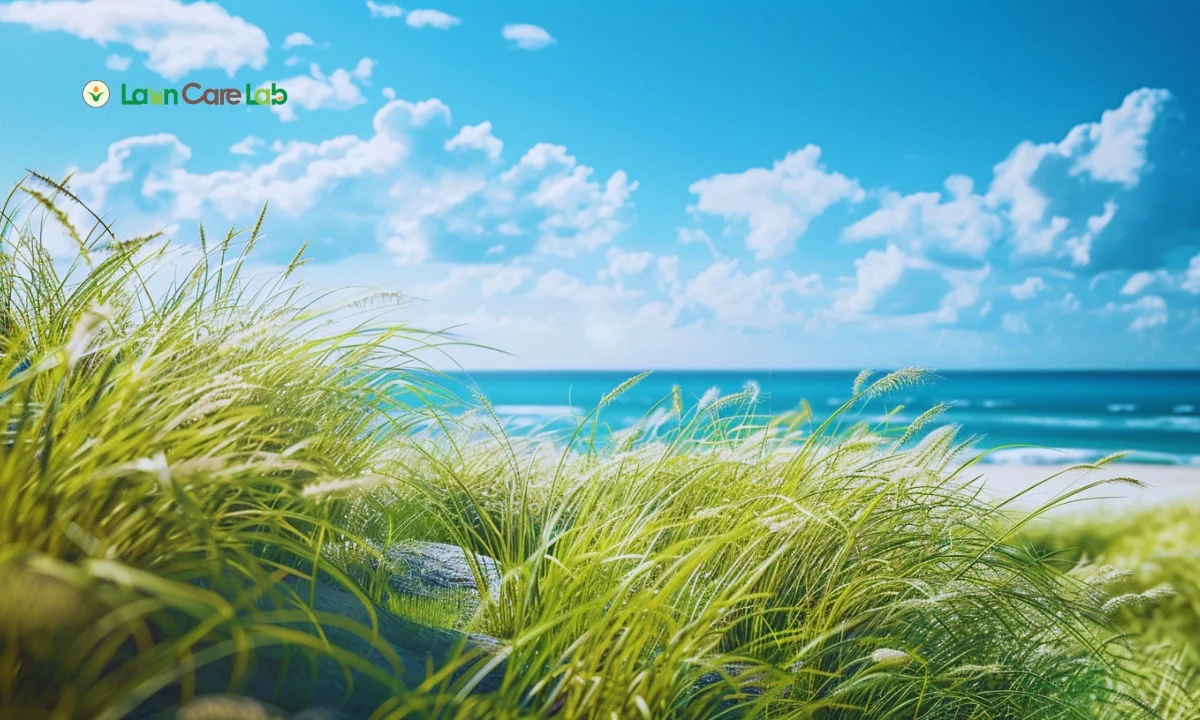Alaskan lawn care can be tough, but we’re here to help. We’ll provide tailored solutions and valuable insights for sustainable practices.
Let’s redefine your approach to lawn care and create a lawn that mirrors Alaska’s resilience and exudes unparalleled beauty.
Table of Contents
The Unique Landscape of Alaskan Lawn Care

Lawn maintenance in Alaska is a unique challenge due to intense sunlight variations, shifting temperatures, and diverse soil conditions.
To care for your lawn effectively, it’s important to understand the distinct ecological zones, from lush rainforests in the Southeast to stark arctic tundra in the North.
The Alaskan Climate and Its Impact on Grass Growth
Alaska’s unique weather patterns, ranging from long summer days to severe winters, present distinct challenges for grass growth and lawn maintenance:
- The extended daylight during summer triggers rapid grass growth, necessitating frequent lawn mowing.
- Brutal winter conditions can significantly harm or even lead to the death of your grass without adequate preparation.
- The short growing season in Alaska’s interior requires carefully selecting quickly maturing and flourishing grass types.
- Coastal zones have milder temperatures and longer growing seasons but require diligent maintenance to stay healthy.
A healthy Alaskan lawn relies on understanding the local climate and adjusting lawn care practices accordingly.
Soil Conditions and Nutrient Availability in Alaska
Caring for your lawn in Alaska can be challenging due to the state’s soil conditions and nutrient availability.
The heavy rainfall and snowmelt often wash away key nutrients, and the soil can be highly acidic.
However, you can create a thriving lawn by adjusting the soil’s pH and supplementing it with necessary nutrients. Navigating lawn care in Alaska requires a thorough understanding of the unique landscape.
With the right approach, you can cultivate an Alaskan lawn that isn’t simply surviving but flourishing.
Common Grass Types Suitable for Alaskan Lawns
The ideal grass types for Alaskan lawns are Kentucky bluegrass, red fescue, and perennial ryegrass.
Here’s why:
- Kentucky Bluegrass: Known for its hardiness, this grass withstands frost while flaunting a stunning blue-green hue.
- Red Fescue: This variety flourishes in shaded locales and demands minimal upkeep, becoming a prime selection for homeowners with wooded lawns.
- Perennial Ryegrass: With its swift germination, this grass promises a dense, verdant lawn in no time.
Choose the right grass for your lawn based on sunlight exposure, soil conditions, and maintenance ability to ensure your lawn and safety thrive.
Handling the Intricacies of Lawn Upkeep in Alaska
Managing a lawn in Alaska can be challenging due to short growing seasons, weeds, and the freeze-thaw cycle. Choose native grass species adapted to the climate and employ strategies that work with it.
Each lawn is unique, so trial and error may be necessary to find the perfect routine. With dedication, you’ll have a beautiful green space to be proud of amidst the Alaskan wilderness.
Overcoming Short-Growing Seasons
Alaska’s climate makes lawn care challenging. You need a flexible approach to maintain a lush lawn due to the short growth periods and unpredictable weather.
- Initiate the seeding process immediately after the soil unfreezes.
- Apply fertilizers at the zenith of growth stages.
- Modulate your lawn’s hydration in response to varying rainfall.
- Prepare your lawn for winter at the earliest opportunity.
You’re nurturing a flourishing, robust lawn by meticulously modifying your routines to Alaska’s distinctive climate.
Dealing with Persistent Weeds and Pests
Controlling weeds and pests in Alaskan lawns can be challenging. But with natural pest control methods like beneficial insects and organic weed killers, you can maintain a lush, pest-free lawn while preserving the ecosystem.
Natural Pest Control Methods for Alaskan Lawns
Here are some practical alternatives to consider:
- Welcoming advantageous insects
- Implementing correct grass-trimming techniques
- Keeping the soil healthy with organic additives
- Applying green practices
Maintain a healthy lawn to control weeds naturally. Use chemicals like 2-4-D for established weeds, but they’re less effective in Alaska’s cool climate. Fertilize regularly. Remove persistent weeds mechanically and ensure complete root extraction. Sustained temperatures of 65-70°F are ideal.
The Troubles with Turf Thawing and Freezing Cycles
Alaskan lawns face challenges due to frequent freeze-thaw cycles, causing damage to grassroots, stunted growth, or even death during winter. Adequate drainage and insulation are key strategies to counteract this.
Use mulch or snow to protect grass and prevent loss of soil moisture. With the right knowledge and precautions, you can help your grass flourish despite the region’s rigorous climate.
Tailored Solutions for Alaskan Lawn Care Success
Let’s discuss advanced gardening methods, optimal fertilizers, and efficient watering techniques to help your Alaskan lawn thrive. Your lawn can flourish even in Alaska’s challenging climate with the right approach.
Innovative Gardening Techniques in Cold Climates
Mulching is a crucial technique for gardening in cold places like Alaska.
It acts as an insulating blanket for soil, preserving warmth and protecting it from harsh cold. This significantly bolsters your garden’s resilience against severe winters.
Mulching and Its Benefits for Soil Insulation
Mulching is essential for maintaining a healthy Alaskan lawn. It provides superior insulation for your soil and offers many benefits.
Let’s break this down:
- It acts as a robust shield for root systems against severe temperatures
- It minimizes the disruptive heaving effect experienced during freeze-thaw cycles
- It aids in retaining necessary soil moisture
- It effectively curbs the proliferation of undesirable weeds
Incorporating mulching into your lawn care routine can result in a flourishing, secure, and aesthetically pleasing outdoor space.
Choosing and Using the Right Fertilizers
For lawns, use 1 pound of nitrogen per 1,000 square feet. Follow instructions for individual plants in gardens.
Use a spreader for lawns or a measuring spoon for small garden beds. Never exceed recommended amounts to avoid the negative impact of over-fertilizing.
Stick to guidelines and adjust practices according to soil test results. Slow-release fertilizers provide a steady supply of nutrients while minimizing the risk of nutrient leaching.
Overusing fertilizers harms the environment, so follow package instructions.
Watering Strategies for Hydration without Over-saturation
Choose the right fertilizer and water appropriately for a healthy lawn in Alaska. Avoid overwatering and maintain optimal moisture levels with a smart watering plan.
Here are some essential strategies to prevent a waterlogged lawn:
- Integrating drip irrigation systems can offer precise control over the water your lawn absorbs.
- Watering in the early dawn or late dusk hours can promote maximum water absorption and reduce water loss through evaporation.
- Regularly check local rainfall data to adapt your watering regimen as required.
- Take steps to enhance soil drainage where needed to avert the risk of waterlogging.
Adopt these strategies to nurture a vibrant lawn that thrives in Alaska, creating an appealing outdoor space.
Sustainable Lawn Care Practices in Alaska
Adopting sustainable lawn care practices in Alaska is key to a thriving yard and a healthier ecosystem. Here’s how to maintain your lawn organically while conserving the environment.
Organic Lawn Management Approaches
Switching to organic lawn management techniques can notably improve the vigor and durability of your Alaskan lawn. These methods, rooted in nurturing a balanced ecosystem, naturally repel pests and weeds, thereby diminishing the need for synthetic chemicals.
Consider the following strategies:
- Enrich your soil using compost or organic fertilizers to foster healthy grass growth.
- Bolster soil fertility with the addition of natural materials.
- Foster biodiversity by incorporating various grass species.
- Regulate water consumption to avoid oversaturation and safeguard this vital resource.
Adopt eco-friendly lawn care techniques for a lush, healthy lawn and a cleaner environment in Alaska.
Conservation Landscaping for Environmental Benefits
Conservation landscaping in Alaska combines eco-friendliness with practical benefits for lawn care by focusing on native plants. This approach leads to substantial environmental gains:
- Native plants thrive in local conditions, minimizing maintenance efforts.
- They naturally deter pests, lessening the need for chemical interventions.
- Diverse native species support a healthier ecosystem within your lawn.
- Incorporating indigenous plants adds aesthetic value while preserving Alaska’s ecological balance.
Native flora enhances resilience, reduces upkeep, and creates sustainable, attractive landscapes that reflect Alaska’s wilderness.
Expert Advice for Year-Round Alaskan Lawn Care

Maintaining a thriving lawn in Alaska can be challenging. Expert advice for every season and professional services can help. Here are some tips for each season:
Spring:
- Tidying Up: Clear any winter debris from your lawn to ensure it has room to breathe.
- Assessing Damage: Look out for any harm caused by frost and plan your recovery strategy accordingly.
- Sowing Early: Use the brief growing season to your advantage by seeding early.
- Ensuring Regular Upkeep: Begin a routine of aeration, fertilization, and mowing to maintain lawn health.
Summer:
- Regularly mow, water, and address weeds and pests to keep your lawn healthy.
- Create a routine of rigorous care to ensure a vibrant lawn for your family to enjoy.
Fall:
- Prepare your lawn for winter by applying specific fertilizers and overseeding.
- Adjust your lawnmower’s setting and clear leaves and debris to prevent lawn diseases.
| Winter Lawn Maintenance | Suggestions |
|---|---|
| Snow Management | Distribute snow uniformly to prevent the formation of mold |
| Traffic Control | Steer clear of extensive foot traffic on dormant grass |
| Regular Check-ups | Keep an eye on your lawn’s state throughout the winter |
Consider hiring professional lawn care services in Alaska for their expertise in local conditions and tailored treatments. They can address lawn issues and ensure optimal health and safety. Trusting professionals give you peace of mind and a thriving lawn all year round.
Conclusion
Maintaining a healthy lawn in Alaska’s distinct landscape is achievable with specific strategies and sustainable methodologies. Professional advice is available year-round.
Perseverance and patience are key to mastering lawn care in the Alaskan terrain.
So, let’s turn your lawn into such a home, nurturing it with love and expert care.
- How to Create a Lawn Care Schedule for Southern Climates - October 30, 2024
- How to Use Compost Tea to Boost Lawn Growth and Soil Health - October 23, 2024
- The Best Grasses for Saltwater-Exposed Lawns: Coastal Lawn Care - October 17, 2024



